Abstract
Interaction of the trypanocide isometamidium chloride with components of Trypanosoma congolense results in characteristic shifts in the intrinsic fluorescence of the drug. The specificity of this interaction was investigated by analysing the effects of various physicochemical manipulations on its fluorescence properties. The characteristic shifts involved a preferential increase in the intensity of one emission peak over the other, resulting in a systematic increase in the ratio of fluorescence intensities. These effects were apparently due to constraints on fluorophore free rotation in the solution (that is, viscosity). Purified DNA produced similar effects in a saturable manner displaying high affinity for the drug, indicating that the constraint involves binding of the drug to high-affinity binding sites within the DNA. Such binding sites were demonstrated in lysates derived from trypanosomal cells. The binding sites were associated with macromolecular species (M(r) > 12000), and were partly disrupted by thermal denaturation and proteolysis. Treatment with DNase 1 produced high levels of disruption of the binding sites (> 85%), indicating an involvement of DNA in the binding. BSA demonstrated weak non-specific binding of the drug. Entry of drug into live trypanosomal cells (monitored by 14C-labelled drug uptake) was paralleled by fluorescence shifts observed under comparable conditions of drug concentration and buffer conditions. Both systems (fluorescence shifts and accumulation of labelled drug) indicated the presence of a saturable membrane transporter with high affinity for the drug. We conclude that monitoring the fluorescence shifts of isometamidium constitutes a sensitive and highly specific probe for entry of the drug into trypanosomal cells, thereby enabling resolution of the transport events involved.
Full text
PDF
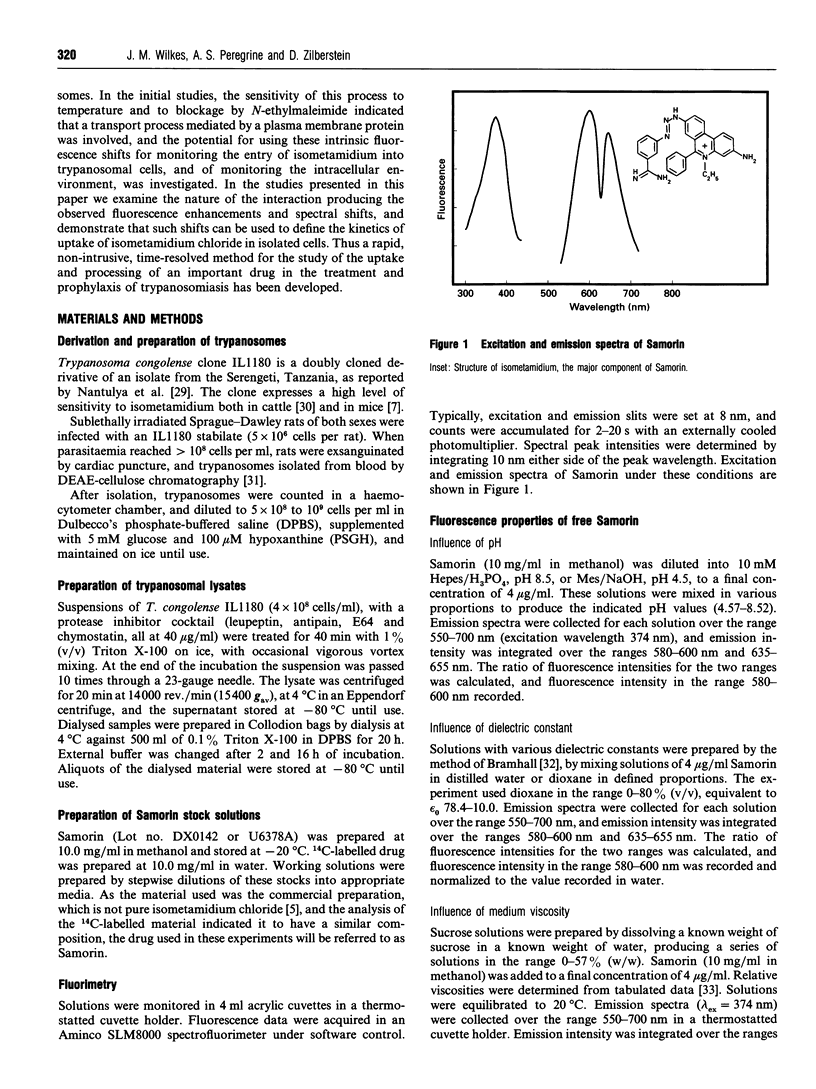
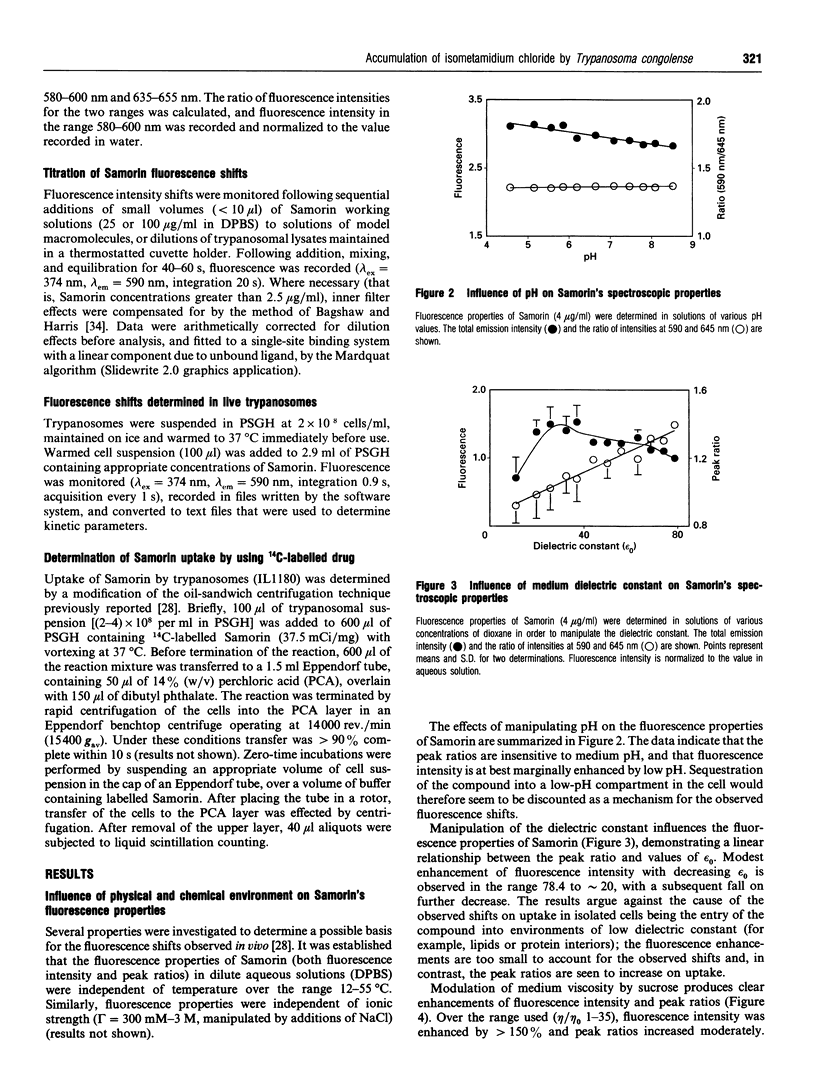
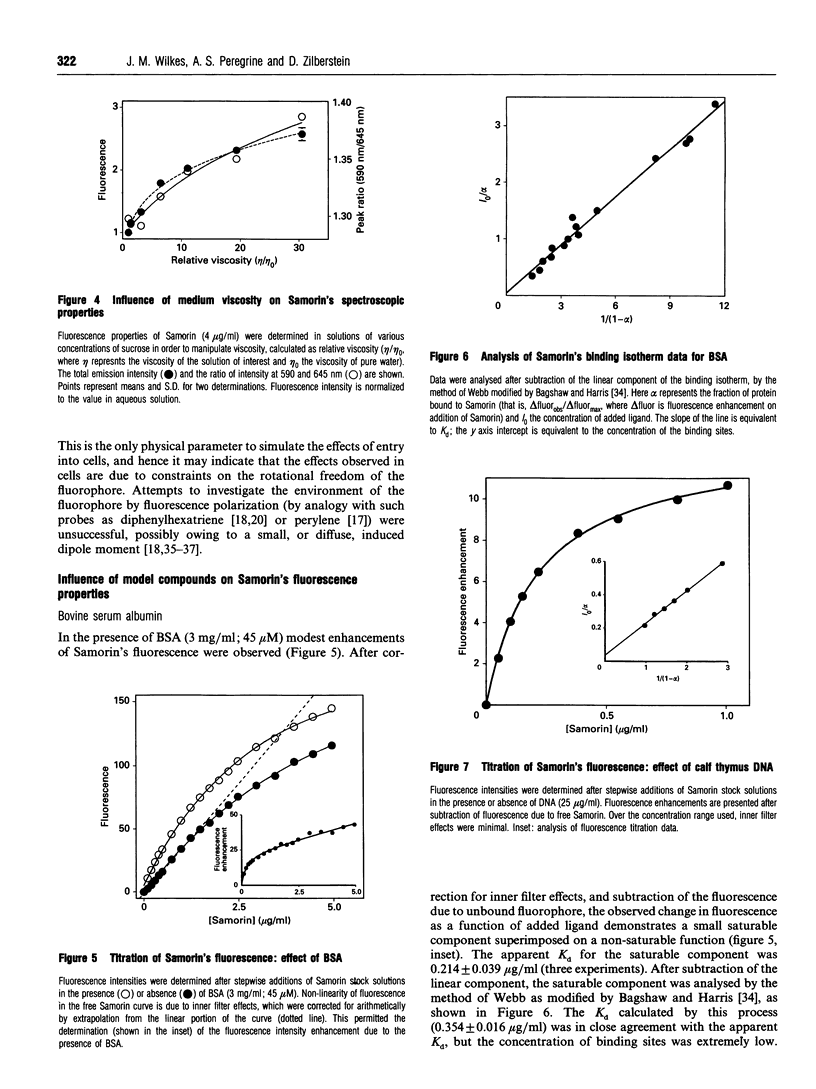
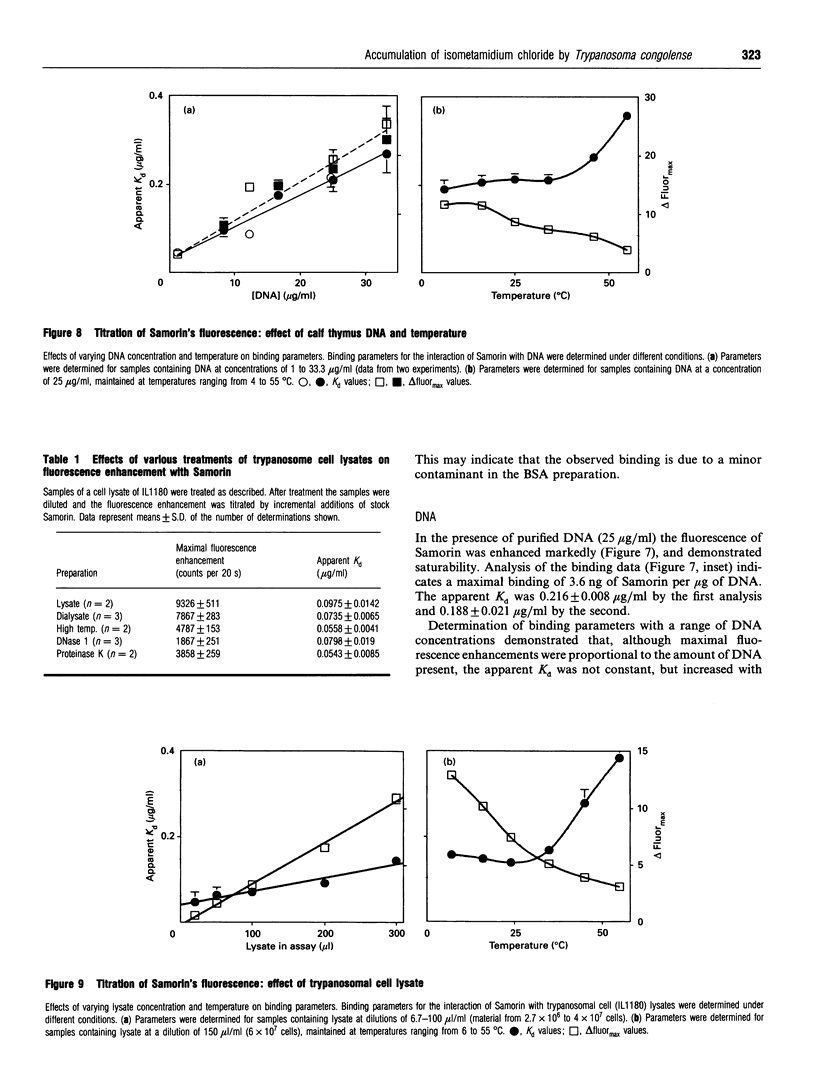
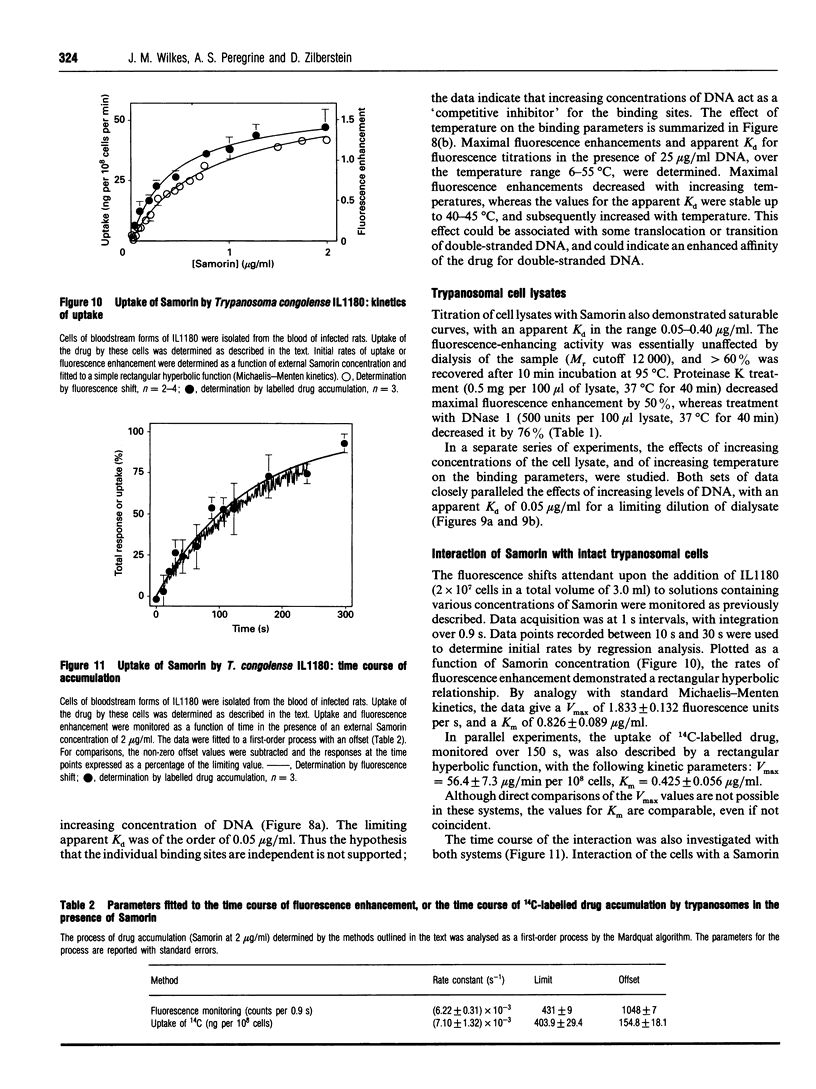

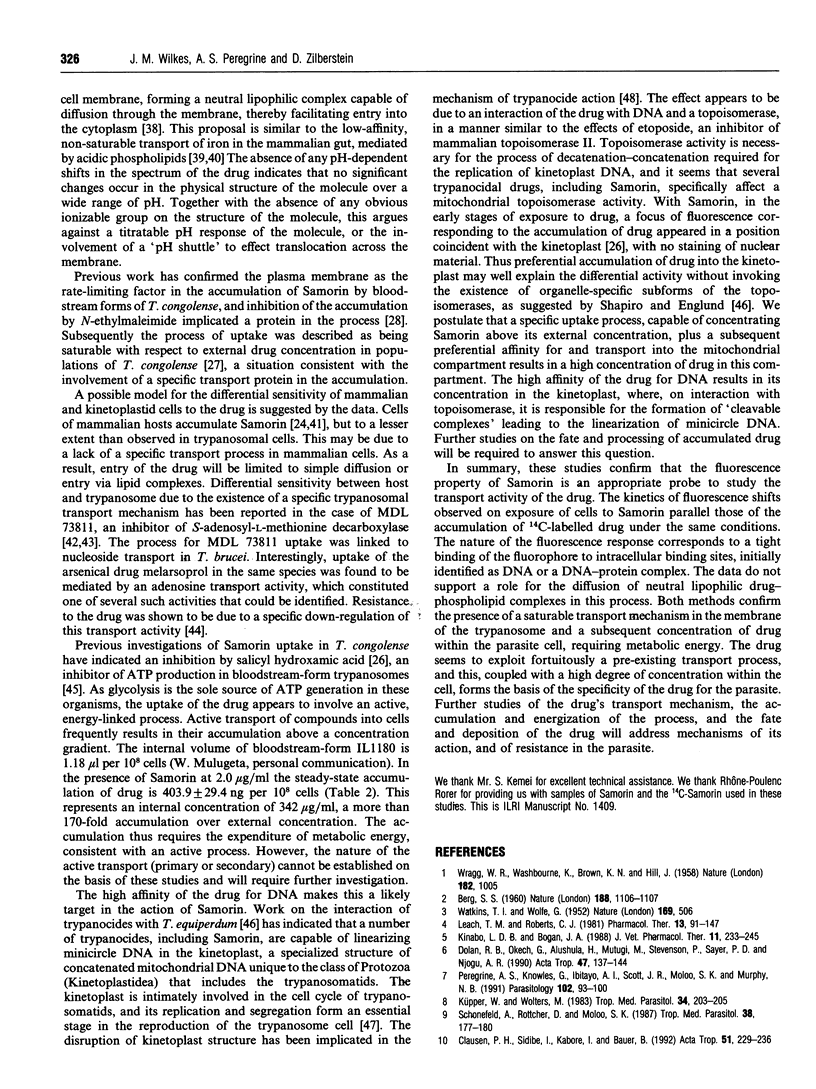

Selected References
These references are in PubMed. This may not be the complete list of references from this article.
- Bramhall J. Phospholipid packing asymmetry in curved membranes detected by fluorescence spectroscopy. Biochemistry. 1986 Jun 3;25(11):3479–3486. doi: 10.1021/bi00359a057. [DOI] [PubMed] [Google Scholar]
- Byers T. L., Bush T. L., McCann P. P., Bitonti A. J. Antitrypanosomal effects of polyamine biosynthesis inhibitors correlate with increases in Trypanosoma brucei brucei S-adenosyl-L-methionine. Biochem J. 1991 Mar 1;274(Pt 2):527–533. doi: 10.1042/bj2740527. [DOI] [PMC free article] [PubMed] [Google Scholar]
- Byers T. L., Casara P., Bitonti A. J. Uptake of the antitrypanosomal drug 5'-([(Z)-4-amino-2-butenyl]methylamino)-5'-deoxyadenosine (MDL 73811) by the purine transport system of Trypanosoma brucei brucei. Biochem J. 1992 May 1;283(Pt 3):755–758. doi: 10.1042/bj2830755. [DOI] [PMC free article] [PubMed] [Google Scholar]
- Carter N. S., Fairlamb A. H. Arsenical-resistant trypanosomes lack an unusual adenosine transporter. Nature. 1993 Jan 14;361(6408):173–176. doi: 10.1038/361173a0. [DOI] [PubMed] [Google Scholar]
- Chitambo H., Arakawa A., Ono T. In vivo assessment of drug sensitivity of African trypanosomes using the akinetoplastic induction test. Res Vet Sci. 1992 Mar;52(2):243–249. doi: 10.1016/0034-5288(92)90017-v. [DOI] [PubMed] [Google Scholar]
- Clausen P. H., Sidibe I., Kaboré I., Bauer B. Development of multiple drug resistance of Trypanosoma congolense in Zebu cattle under high natural tsetse fly challenge in the pastoral zone of Samorogouan, Burkina Faso. Acta Trop. 1992 Aug;51(3-4):229–236. doi: 10.1016/0001-706x(92)90041-u. [DOI] [PubMed] [Google Scholar]
- Cobbold P. H., Rink T. J. Fluorescence and bioluminescence measurement of cytoplasmic free calcium. Biochem J. 1987 Dec 1;248(2):313–328. doi: 10.1042/bj2480313. [DOI] [PMC free article] [PubMed] [Google Scholar]
- Codjia V., Mulatu W., Majiwa P. A., Leak S. G., Rowlands G. J., Authié E., d'Ieteren G. D., Peregrine A. S. Epidemiology of bovine trypanosomiasis in the Ghibe valley, southwest Ethiopia. 3. Occurrence of populations of Trypanosoma congolense resistant to diminazene, isometamidium and homidium. Acta Trop. 1993 Apr;53(2):151–163. doi: 10.1016/0001-706x(93)90026-8. [DOI] [PubMed] [Google Scholar]
- Dolan R. B., Okech G., Alushula H., Mutugi M., Stevenson P., Sayer P. D., Njogu A. R. Homidium bromide as a chemoprophylactic for cattle trypanosomiasis in Kenya. Acta Trop. 1990 Mar;47(3):137–144. doi: 10.1016/0001-706x(90)90019-v. [DOI] [PubMed] [Google Scholar]
- Fairlamb A. H., Opperdoes F. R., Borst P. New approach to screening drugs for activity against African trypanosomes. Nature. 1977 Jan 20;265(5591):270–271. doi: 10.1038/265270a0. [DOI] [PubMed] [Google Scholar]
- Freedman J. C., Novak T. S. Optical measurement of membrane potential in cells, organelles, and vesicles. Methods Enzymol. 1989;172:102–122. doi: 10.1016/s0076-6879(89)72011-5. [DOI] [PubMed] [Google Scholar]
- Frezard F., Garnier-Suillerot A. Comparison of the membrane transport of anthracycline derivatives in drug-resistant and drug-sensitive K562 cells. Eur J Biochem. 1991 Mar 14;196(2):483–491. doi: 10.1111/j.1432-1033.1991.tb15840.x. [DOI] [PubMed] [Google Scholar]
- Heyn M. P. Determination of lipid order parameters and rotational correlation times from fluorescence depolarization experiments. FEBS Lett. 1979 Dec 15;108(2):359–364. doi: 10.1016/0014-5793(79)80564-5. [DOI] [PubMed] [Google Scholar]
- Jähnig F. Structural order of lipids and proteins in membranes: evaluation of fluorescence anisotropy data. Proc Natl Acad Sci U S A. 1979 Dec;76(12):6361–6365. doi: 10.1073/pnas.76.12.6361. [DOI] [PMC free article] [PubMed] [Google Scholar]
- Kinabo L. D., Bogan J. A. Binding of isometamidium to calf thymus DNA and lipids: pharmacological implications. J Vet Pharmacol Ther. 1987 Dec;10(4):357–362. doi: 10.1111/j.1365-2885.1987.tb00115.x. [DOI] [PubMed] [Google Scholar]
- Kinabo L. D., Bogan J. A. Solid-phase extraction and ion-pair reversed-phase HPLC of isometamidium in bovine serum and tissues. Acta Trop. 1988 Jun;45(2):165–170. [PubMed] [Google Scholar]
- Kinabo L. D., Bogan J. A. The pharmacology of isometamidium. J Vet Pharmacol Ther. 1988 Sep;11(3):233–245. doi: 10.1111/j.1365-2885.1988.tb00148.x. [DOI] [PubMed] [Google Scholar]
- Kinabo L. D., McKellar Q. A., Eckersall P. D. Isometamidium in pigs: disposition kinetics, tissue residues and adverse reactions. Res Vet Sci. 1991 Jan;50(1):6–13. doi: 10.1016/0034-5288(91)90045-p. [DOI] [PubMed] [Google Scholar]
- Kuhry J. G., Duportail G., Bronner C., Laustriat G. Plasma membrane fluidity measurements on whole living cells by fluorescence anisotropy of trimethylammoniumdiphenylhexatriene. Biochim Biophys Acta. 1985 Apr 22;845(1):60–67. doi: 10.1016/0167-4889(85)90055-2. [DOI] [PubMed] [Google Scholar]
- Küpper W., Wolters M. Observation on drug resistance of Trypanosoma (Nannomonas) congolense and Trypanosoma (Duttonella) vivax in cattle at a feedlot in the Northern Ivory Coast. Tropenmed Parasitol. 1983 Sep;34(3):203–205. [PubMed] [Google Scholar]
- Lanham S. M., Godfrey D. G. Isolation of salivarian trypanosomes from man and other mammals using DEAE-cellulose. Exp Parasitol. 1970 Dec;28(3):521–534. doi: 10.1016/0014-4894(70)90120-7. [DOI] [PubMed] [Google Scholar]
- Leach T. M., Roberts C. J. Present status of chemotherapy and chemoprophylaxis of animal trypanosomiasis in the Eastern hemisphere. Pharmacol Ther. 1981;13(1):91–147. doi: 10.1016/0163-7258(81)90069-3. [DOI] [PubMed] [Google Scholar]
- Litman B. J., Barenholz Y. Fluorescent probe: diphenylhexatriene. Methods Enzymol. 1982;81:678–685. doi: 10.1016/s0076-6879(82)81093-8. [DOI] [PubMed] [Google Scholar]
- Minta A., Tsien R. Y. Fluorescent indicators for cytosolic sodium. J Biol Chem. 1989 Nov 15;264(32):19449–19457. [PubMed] [Google Scholar]
- Nantulya V. M., Musoke A. J., Rurangirwa F. R., Moloo S. K. Resistance of cattle to tsetse-transmitted challenge with Trypanosoma brucei or Trypanosoma congolense after spontaneous recovery from syringe-passaged infections. Infect Immun. 1984 Feb;43(2):735–738. doi: 10.1128/iai.43.2.735-738.1984. [DOI] [PMC free article] [PubMed] [Google Scholar]
- Peregrine A. S., Knowles G., Ibitayo A. I., Scott J. R., Moloo S. K., Murphy N. B. Variation in resistance to isometamidium chloride and diminazene aceturate by clones derived from a stock of Trypanosoma congolense. Parasitology. 1991 Feb;102(Pt 1):93–100. doi: 10.1017/s0031182000060388. [DOI] [PubMed] [Google Scholar]
- Philips F. S., Sternberg S. S., Cronin A. P., Sodergren J. E., Vidal P. M. Physiologic disposition and intracellular localization of isometamidium. Cancer Res. 1967 Feb;27(2):333–349. [PubMed] [Google Scholar]
- Robinson D. R., Gull K. Basal body movements as a mechanism for mitochondrial genome segregation in the trypanosome cell cycle. Nature. 1991 Aug 22;352(6337):731–733. doi: 10.1038/352731a0. [DOI] [PubMed] [Google Scholar]
- Roepe P. D. Analysis of the steady-state and initial rate of doxorubicin efflux from a series of multidrug-resistant cells expressing different levels of P-glycoprotein. Biochemistry. 1992 Dec 22;31(50):12555–12564. doi: 10.1021/bi00165a003. [DOI] [PubMed] [Google Scholar]
- Shapiro T. A., Englund P. T. Selective cleavage of kinetoplast DNA minicircles promoted by antitrypanosomal drugs. Proc Natl Acad Sci U S A. 1990 Feb;87(3):950–954. doi: 10.1073/pnas.87.3.950. [DOI] [PMC free article] [PubMed] [Google Scholar]
- Shinitzky M., Dianoux A. C., Gitler C., Weber G. Microviscosity and order in the hydrocarbon region of micelles and membranes determined with fluorescent probes. I. Synthetic micelles. Biochemistry. 1971 May 25;10(11):2106–2113. doi: 10.1021/bi00787a023. [DOI] [PubMed] [Google Scholar]
- Shinitzky M., Inbar M. Microviscosity parameters and protein mobility in biological membranes. Biochim Biophys Acta. 1976 Apr 16;433(1):133–149. doi: 10.1016/0005-2736(76)90183-8. [DOI] [PubMed] [Google Scholar]
- Simpson R. J., Peters T. J. Iron-binding lipids of rabbit duodenal brush-border membrane. Biochim Biophys Acta. 1987 Apr 9;898(2):181–186. doi: 10.1016/0005-2736(87)90036-8. [DOI] [PubMed] [Google Scholar]
- Simpson R. J., Peters T. J. Transport of Fe2+ across lipid bilayers: possible role of free fatty acids. Biochim Biophys Acta. 1987 Apr 9;898(2):187–195. doi: 10.1016/0005-2736(87)90037-x. [DOI] [PubMed] [Google Scholar]
- Sones K. R., Njogu A. R., Holmes P. H. Assessment of sensitivity of Trypanosoma congolense to isometamidium chloride: a comparison of tests using cattle and mice. Acta Trop. 1988 Jun;45(2):153–164. [PubMed] [Google Scholar]
- Sutherland I. A., Mounsey A., Holmes P. H. Transport of isometamidium (Samorin) by drug-resistant and drug-sensitive Trypanosoma congolense. Parasitology. 1992 Jun;104(Pt 3):461–467. doi: 10.1017/s0031182000063721. [DOI] [PubMed] [Google Scholar]
- Sutherland I. A., Peregrine A. S., Lonsdale-Eccles J. D., Holmes P. H. Reduced accumulation of isometamidium by drug-resistant Trypanosoma congolense. Parasitology. 1991 Oct;103(Pt 2):245–251. doi: 10.1017/s0031182000059527. [DOI] [PubMed] [Google Scholar]
- Tsien R. Y., Pozzan T., Rink T. J. Calcium homeostasis in intact lymphocytes: cytoplasmic free calcium monitored with a new, intracellularly trapped fluorescent indicator. J Cell Biol. 1982 Aug;94(2):325–334. doi: 10.1083/jcb.94.2.325. [DOI] [PMC free article] [PubMed] [Google Scholar]
- WATKINS T. I., WOOLFE G. Effect of changing the quaternizing group on the trypanocidal activity of dimidium bromide. Nature. 1952 Mar 22;169(4299):506–507. doi: 10.1038/169506a0. [DOI] [PubMed] [Google Scholar]
- WRAGG W. R., WASHBOURN K., BROWN K. N., HILL J. Metamidium: a new trypanocidal drug. Nature. 1958 Oct 11;182(4641):1005–1006. doi: 10.1038/1821005a0. [DOI] [PubMed] [Google Scholar]
- Wilkes J. M., Ballard H. J., Dryden D. T., Hirst B. H. Proton permeability and lipid dynamics of gastric and duodenal apical membrane vesicles. Am J Physiol. 1989 Mar;256(3 Pt 1):G553–G562. doi: 10.1152/ajpgi.1989.256.3.G553. [DOI] [PubMed] [Google Scholar]
- Wilkes J. M., Kajimura M., Scott D. R., Hersey S. J., Sachs G. Muscarinic responses of gastric parietal cells. J Membr Biol. 1991 Jun;122(2):97–110. doi: 10.1007/BF01872634. [DOI] [PubMed] [Google Scholar]
- Zilberstein D., Wilkes J., Hirumi H., Peregrine A. S. Fluorescence analysis of the interaction of isometamidium with Trypanosoma congolense. Biochem J. 1993 May 15;292(Pt 1):31–35. doi: 10.1042/bj2920031. [DOI] [PMC free article] [PubMed] [Google Scholar]
- van der Graaf W. T., de Vries E. G., Uges D. R., Nanninga A. G., Meijer C., Vellenga E., Mulder P. O., Mulder N. H. In vitro and in vivo modulation of multi-drug resistance with amiodarone. Int J Cancer. 1991 Jun 19;48(4):616–622. doi: 10.1002/ijc.2910480422. [DOI] [PubMed] [Google Scholar]


